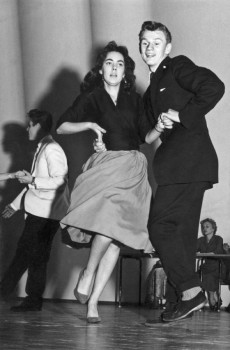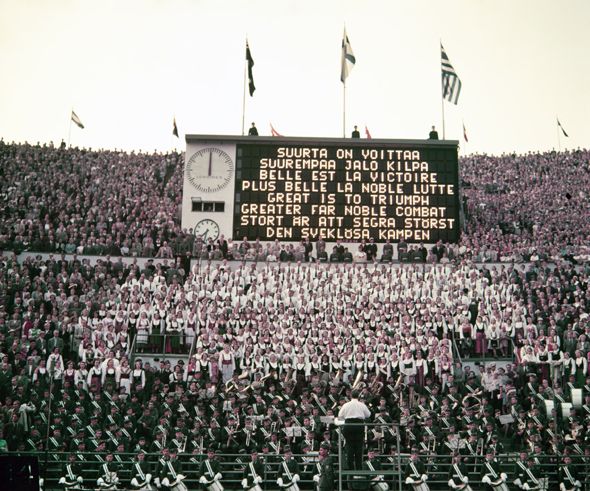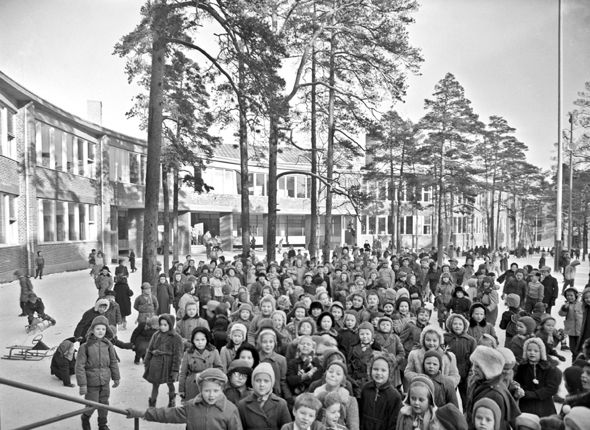Decade of youth: the 1950s revisited
30 January 2014 | Reviews

Rock around the clock in Helsinki, too! All photos here from Rasvaletti; photographer unknown, 1958
Rasvaletti. Valokuvia 1950-luvun Helsingistä /
Fotografier från 1950-talets Helsingfors
[Hair-grease. Photographs from 1950s Helsinki]
Työryhmä [working group]: Yki Hytönen, Tuomas Myrén, Riitta Pakarinen, Aki Pohjankyrö, Hilkka Vallisaari
Helsinki: Helsingin kaupunginmuseo, Helsinki City Museum,
2013. 211 pp., ill.
ISBN 978-952-272-499-1
€45, hardback
Onnen aika? Valoja ja varjoja 1950-luvulla
[Time of happiness? Light and shadow in the 1950s]
Toimittaneet [Ed. by]: Kirsi-Maria Hytönen & Keijo Rantanen
Jyväskylä: Atena, 2013. 249 pp., ill.
ISBN 978-951-796-924-6
38€, hardback
The 1950s rocked! They literally did – that is when the world got rhythm: Blue Suede Shoes by Elvis and the film Blackboard Jungle, with Bill Haley’s hit Rock Around the Clock, for example.
The development of new sound reproduction – long-playing records and tape recorders – was essential to the spreading of the gospel of rock and pop here, there and everywhere.
In Finland, the shocking new music was a smash hit among a group of young urban men called lättähatut, flathats, who also wore tight trousers, black overcoats and pointed shoes. Their girls dressed in angora sweaters and tight trousers or skirts. These teenagers, who hung around together very late in the evenings, were largely considered not only a nuisance but also a possible danger to the peaceful development of society (not only in Finland…).

Catching the rays: this swimmer has dipped herself in icy water and pretends it’s time to get a tan. A sunny winter day in Helsinki, 1952. Photo: Väinö Kannisto
The war was over; after chaos order was highly valued, which must be one of the reasons why young people were so widely frowned upon for being radically different from their parents, for breaking the – still strict – rules of behaviour and appearances.
Interest in and nostalgia for this colourful decade has grown recently, in Finland, at least. Two new books were published last year. Rasvaletti is the title of both a book and an extremely popular photographic exhibition at the Helsinki City Museum, opened last autumn.

Suburban idyll? Children looking over the newly built suburb of Maunula in Helsinki. Photo: Hulkkonen, 1957–58
This city is full of people who were young in the 1950s, and taking a trip down memory lane to one’s early decades breeds pleasurable nostalgia.
The photographs present the reader with a wealth of views of the city and its inhabitants at work and at play, confirming the fact that after the war Helsinki was chock-full of children and teenagers. New suburbs popped up like mushrooms.
A general feeling of joie de vivre comes across in the photographs, many of them colour images seasoned with the pastel hues of the time.
The articles in Onnen aika? set out to look beyond those pastels. Life was not just about increasing creature comforts, blue jeans and rock ‘n’ roll. When the decade began, only five years had passed since the end of the Second World War: more than 90,000 men had died, more than 200,000 wounded. More than 100,000 evacuee families needed homes. War reparations to the Soviet Union were worth almost 600 million US dollars (five per cent of the GDP in 1945–48), payable mainly in products of the metal industry (but for example also 15,000 Finnhorses were included).
Society changed rapidly: young people left the countryside to look for jobs in towns. Workers protested as prices rose up but wages did not: a general strike took place in 1956 – and in 1957, rather bizarrely, the state treasury even momentarily declared insolvency, briefly stopping all payments.

Gallows humour: blind men were taught to be masseurs. Photo: Väinö Kannisto, 1950
The Fifties is also described as the decade of housewives. In Finland, the cost of living was high, many consumer goods were still rationed, social services such as day care for children were scarce, so mothers stayed home cooking, cleaning, making ends meet – and making babies. The baby-boom from 1946 to 1949 meant more than 100,000 babies each year (compared to around 60,000 in the 2000s).
After the Second World War a similar phenomenon occurred all over the world, regardless of whether the country had participated in the war or not. But in Finland the baby boomer generations were among largest in the world when compared to the generations before or after them, and three-quarters of the children were born in the countryside.
Many rather ground-breaking changes took place in the post-war decade. The standard of living slowly began to rise after ages of shortage, depression, want, slump and compulsory thrift.
Creativity revived: in the 1950s the concept of ‘Finnish design’ began to flourish; Finnish authors began surfing on a new, strong modernist wave of literature that swept over the land. Coffee was at last freely available in the shops in 1954, and the first television broadcast was aired in 1955. Gee whiz!
1952 was a special year in Finland: the Olympics took place in Helsinki, the blonde country girl Armi Kuusela was chosen Miss Universe – resulting in huge media attention for years, even decades, after she married a Filipino – and the last war reparations train crossed the border. A new, happier era had definitely started.

Noble combat: the final celebrations of the Olympics at the Helsinki stadium. Photo: Olympia-Kuva, 1952
In the photos of Rasvaletti children – lots of children – crowd the schoolyards and play in brand-new suburban surroundings. Reminders of the war that had finished just a short time ago, legless men sit in three-wheelers or weave baskets, wearing dark glasses.
But people often smile: nothing could be as bad as war.

School, everybody: children at the new Meilahti school in Helsinki. Photographer unknown, 1954
Tags: 1950s, Finnish history, Finnish society, Helsinki, photography
No comments for this entry yet
